

William Stopford
The cars axed in 2025 that we'll miss the most
19 Hours Ago
The Hyundai Santa Fe has received its most daring redesign ever, and yet it has become even more practical.
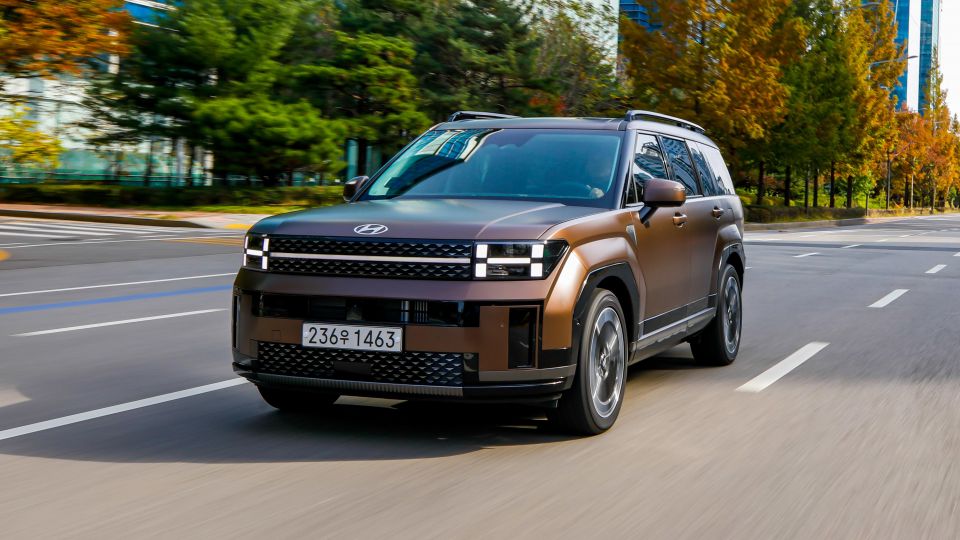
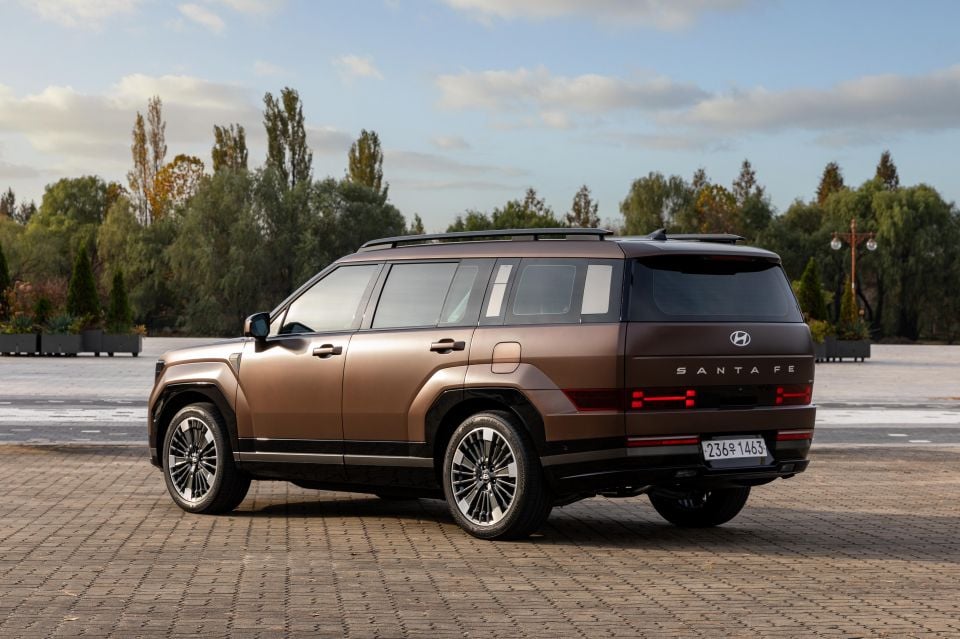

Quickly see how this car stacks up against its competition. Select any benchmark to see more details.
Where expert car reviews meet expert car buying – CarExpert gives you trusted advice, personalised service and real savings on your next new car.
There’s been a clear continuity in design with each generation of Hyundai Santa Fe, until now.

Gone is the inoffensive shape of the outgoing vehicle that blends in with suburban Australia as easily as rendered walls and mondo grass. In its place is this brash box that’s more of an amalgam of the Land Rover Defender and Ford Flex with, as one fellow journalist pointed out, a hint of Austin Princess at the rear.
There are some distinctive colours too, including a rich olive green, a deep matte brown, and a bright orange, while there are flared arches and neat details like headlight and tail light graphics in the shape of the letter ‘H’, and a little handle in the C-pillar.
You are either going to love the new Santa Fe or hate it. Or, like me, you’ll like all bar the very rear, with its slightly pinched bottom and oddly low tail lights. Hyundai, why do you keep putting the rear lights so low?
Given it’s a big box on wheels, it’s not the slipperiest thing. With a drag coefficient of 0.29, however, it cuts through the air better than its corporate cousin, the Kia Sorento (0.32).

With the Sorento overtaking the Santa Fe in the sales race in markets like Australia and South Korea, Hyundai designers clearly thought a bold makeover was in order.
It’s not simply a case of style over substance, however. The Santa Fe is 45mm longer and 35mm taller with a 15mm longer wheelbase, which has paid off in terms of interior space. More on that later.
Given carmakers have been increasing prices lately even when the cars themselves have been unchanged, this radically different Santa Fe will almost certainly wear a higher price tag when it arrives here in the second quarter of 2024.
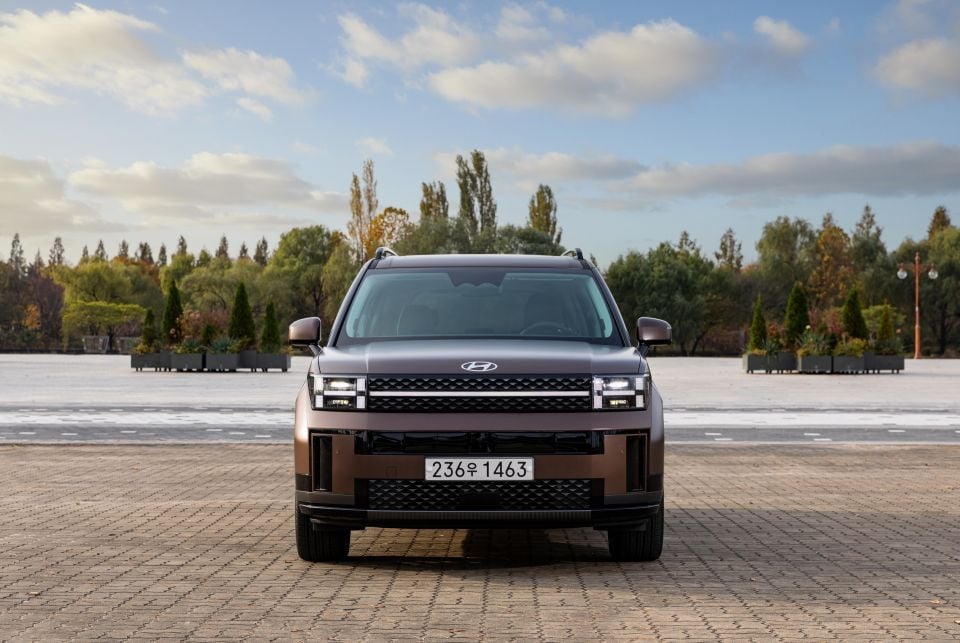
Hyundai has yet to confirm pricing for the new-generation range, though the current line-up is priced from $46,050 before on-road costs for the base front-wheel drive V6 all the way up to $69,550 before on-roads for the Hybrid Highlander.
It’s not just the pricing that we don’t yet know. Hyundai has yet to confirm what the local Santa Fe range will look like, beyond confirming it will launch in Australia exclusively with an all-wheel drive hybrid powertrain.
It has yet to reveal a diesel version, and indeed the new Santa Fe – referred to internally as the MX5, just to confuse people – was revealed with a range of petrol, hybrid and plug-in hybrid powertrains.
These include naturally aspirated and turbocharged 2.5-litre four-cylinder engines, as well as hybrid and plug-in hybrid turbocharged 1.6-litre fours.

We don’t expect the plug-in hybrid or naturally aspirated 2.5-litre four to come to Australia, but we expect the turbo 2.5-litre four-cylinder engine to do so. Whether we get it with both front- and all-wheel drive, as it can be had in South Korea, is another unanswered question.
Hyundai says it considers the Santa Fe a rival to the Kia Sorento, Toyota Kluger and Subaru Outback, although in Europe it says it’s more of a rival to the likes of the BMW X3 and Volvo XC60.
Buy your new car without the stress. It's fast, simple and completely free.

Great service from Travis and team, second time I have used this business would not hesitate to recommend them to anyone
Craig C.
Purchased a Ford Ranger in Sunshine Coast, QLD
CarExpert helped Craig save thousands on his Ford Ranger, now let us save you on your next new car.
Find a dealThe rectilinear design language carries through to the interior, though there are some subtle curves to stop it looking too 1980s.
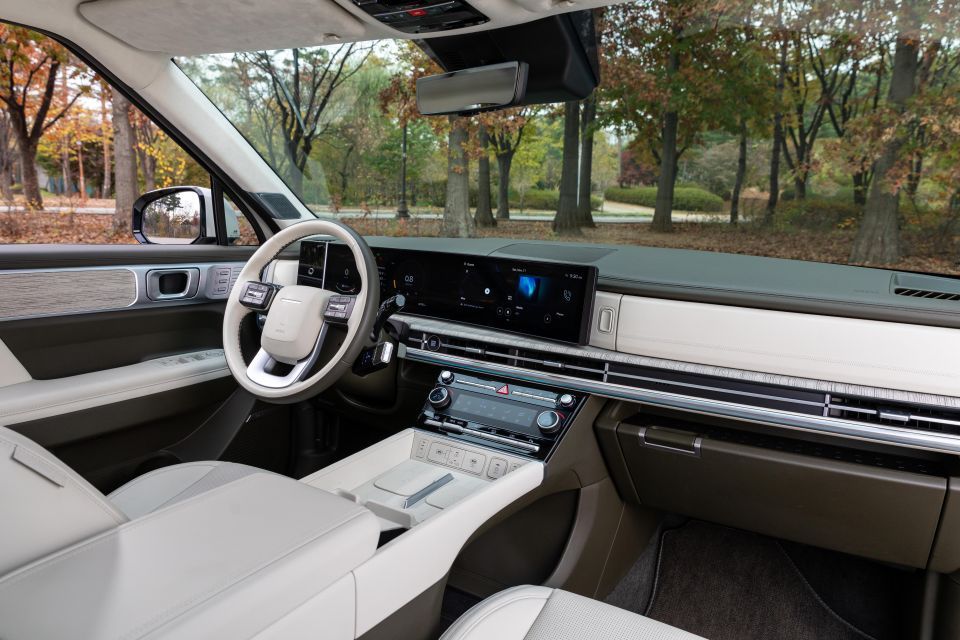
The screen assembly, for example, has a slight curve to it, with the dashboard behind it also bending slightly to accommodate it. It features a 12.3-inch digital instrument cluster and a 12.3-inch infotainment touchscreen.
It’s all quite handsome, while material quality is generally quite good. There’s soft padding on either side of the centre console, plus a soft-touch dash top and door tops. The middle part of the door cards is finished in hard plastic however, even in the top-spec Calligraphy. Odd.
The Calligraphy does at least get a suede headliner, while one of the testers we drove had an unusual two-tone avocado green and cream interior which, in case you’re worried, looks a lot better in person than it sounds. There’s also distinctive wood-look trim, similar to that seen in the larger Palisade, which is a bit Shabby Chic.

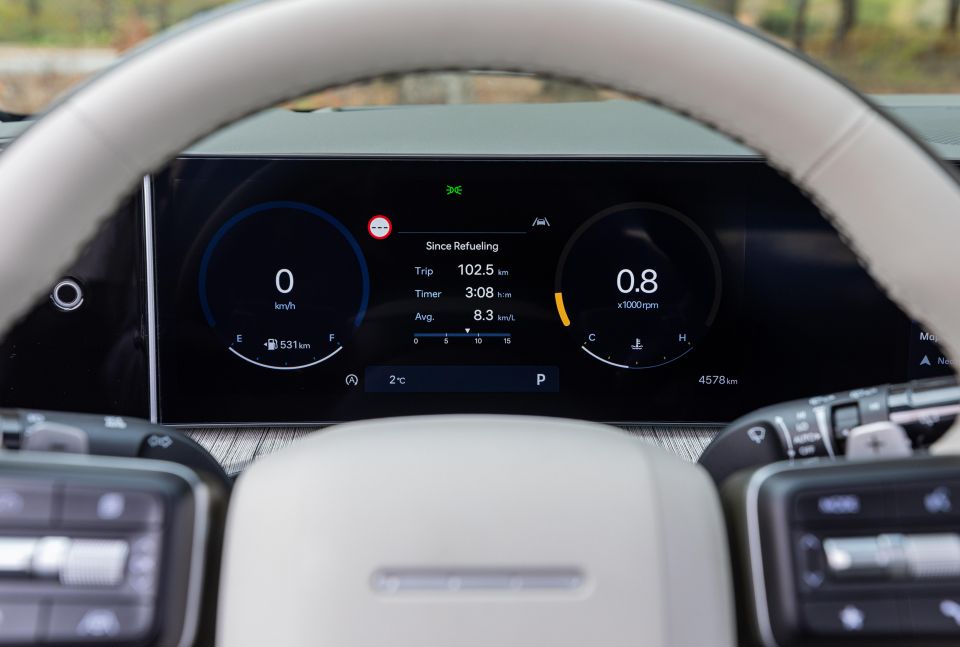
Hyundai will offer the Santa Fe with a range of interior colourways and, while it hasn’t confirmed which will be offered here, the brand has historically been more open to bringing different colour cabins to Australia than cousin Kia.
There’s Obsidian Black, Supersonic Grey, Pecan Brown, Forest Green and Black Ink, each with its own corresponding inlay depending on the variant. The inlay options are mostly wood-look, though there is one black metal trim available on certain Santa Fe models.
Calligraphy models come with dual wireless phone chargers in plain view on the squared-off centre console – not awkwardly angled, not tucked away in a recess, just simple, flat chargers. They also include clearly visible green progress lights.
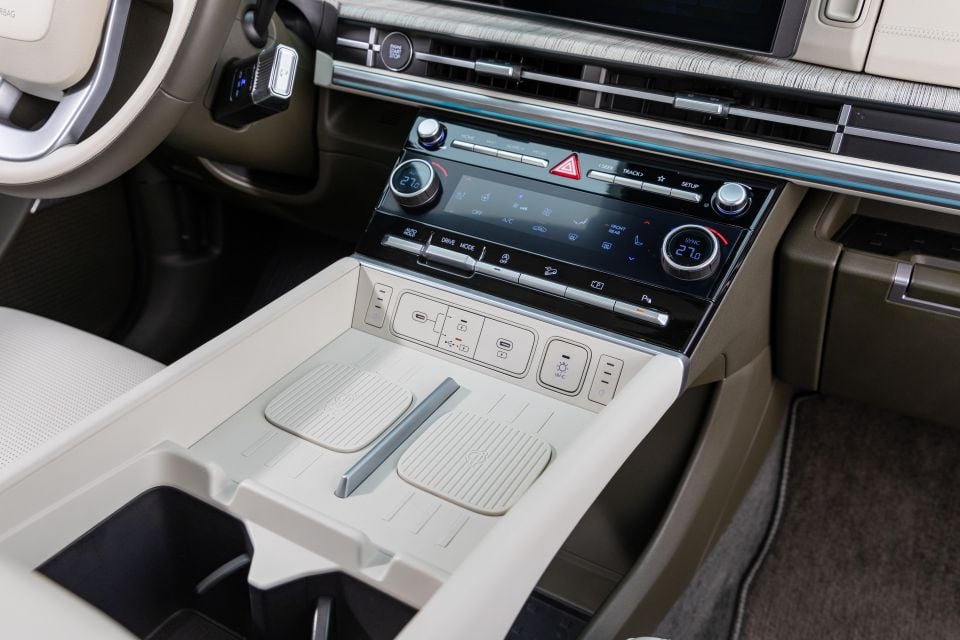
Under the centre console, as with the old car there’s a handy shelf. There’s also a shelf on the passenger side of the dashboard, plus a second glove compartment.
You’ll struggle to fit much in the latter, but extra storage is extra storage. The fairly deep centre console compartment also cleverly opens from both the front seats and the rear.
There’s no longer a conventional or push-button shifter on the centre console, with the shifter now located on the steering column like in the Ioniq 5 electric vehicle. It has a substantial feel to it, is easy to use, and is vastly preferable to the finicky push-button shifter of outgoing up-spec Santa Fe models.
The Santa Fe follows one ubiquitous trend in interior design today: quasi-hidden air vents, which in the Hyundai are much better executed than in some rivals and resemble the front and rear lighting elements on the exterior.
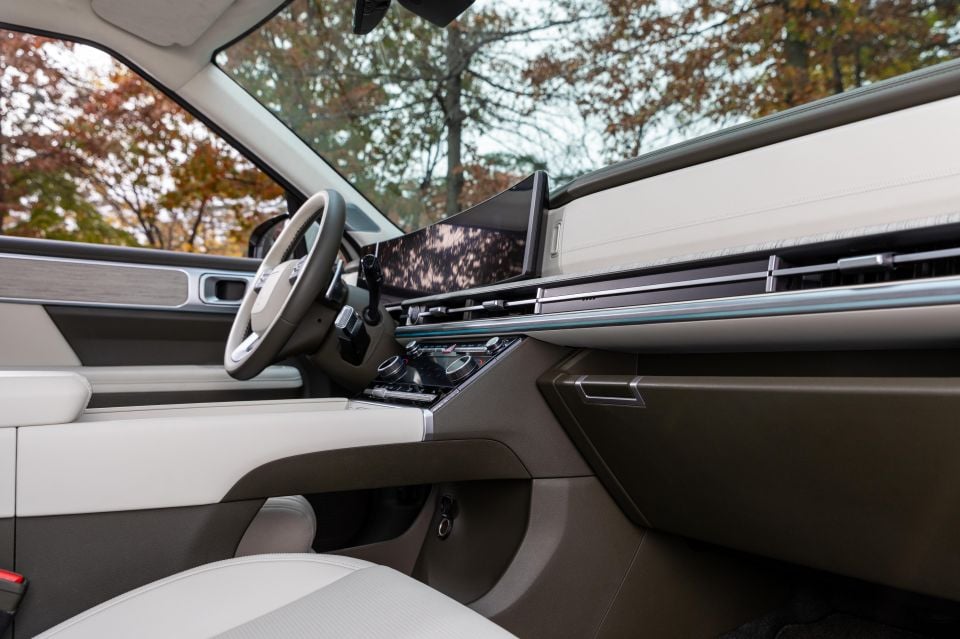
There’s also colour-adjustable ambient lighting, seemingly mandatory in an up-spec vehicle in 2023. Cleverly, it changes to red to let you know if you’re exceeding the speed limit and there’s a speed camera coming up.
The Santa Fe has Hyundai’s latest generation of infotainment, called Connected Car Navigation Cockpit (ccNC). The outgoing Santa Fe’s system was already good, but this boasts even more attractive graphics plus, at long last; wireless Apple CarPlay and Android Auto connectivity.
The surround-view camera system is also sharp, and features a 3D view as seen in systems from BMW and GWM, allowing you to swipe around the vehicle.
Below the infotainment touchscreen is a touch-capacitive 6.6-inch climate control panel. We’d prefer simple buttons, but this array looks slick and there are still traditional knobs for adjusting the temperature.
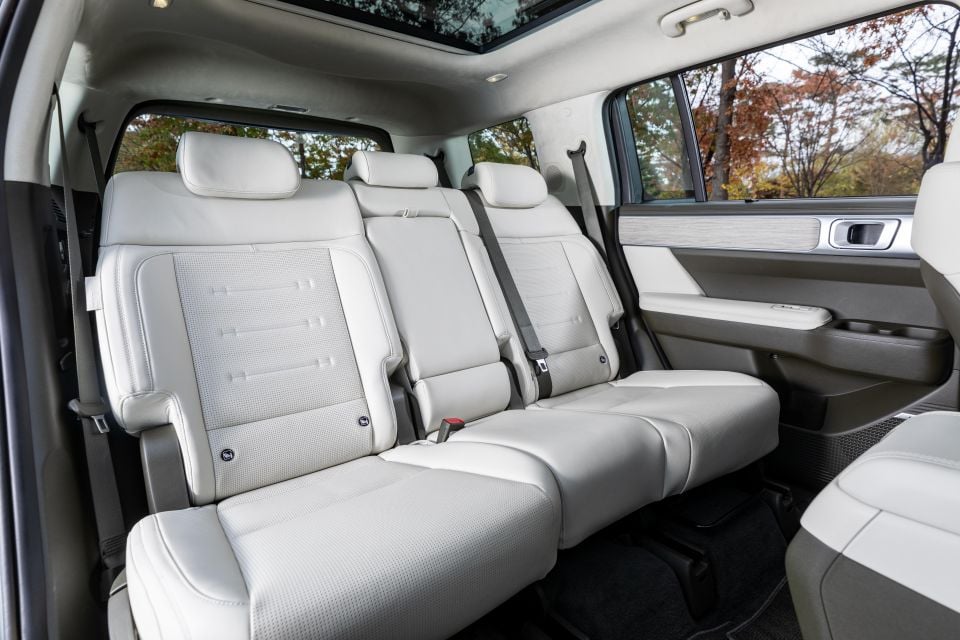
Hyundai has also upgraded to USB-C outlets. There are two of these for each row of seating.
In Korea, the Santa Fe can be had with either five, six or seven seats, with the six-seat layout featuring second-row captain’s chairs.
Second row space is ample, with plenty of leg room and knee room, and a mostly flat floor. There are also two cupholders in each door, plus a fold-down armrest with two more cupholders. There are B-pillar-mounted air vents instead of ones at the rear of the centre console.
Hyundai says it has increased second-row legroom by 20mm in hybrid models and 35mm in petrol models.
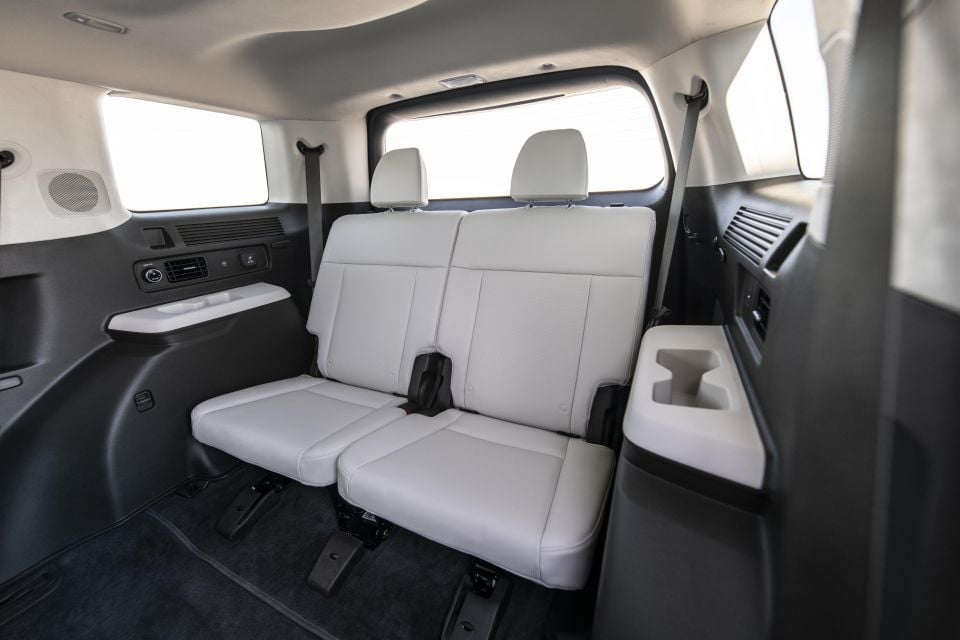
In the top-spec Calligraphy we drove, you press one button and the second-row seat tilts forward. Thanks to the boxy shape, there’s a decently sized opening to clamber through to get to the third row.
You expect a spacious second row in an SUV this size, but you’re not always guaranteed a genuinely comfortable third row. The Santa Fe’s third row has 958mm of headroom and 761mm of legroom. A Kluger, in contrast, has 917mm of headroom and 704mm of legroom – advantage, Hyundai.
I’m 180cm tall, and I could sit behind myself in the third row with plenty of legroom (up 15mm on the outgoing car) and a comfortable amount of headroom (up 69mm), aided by the Santa Fe’s boxy new shape.
The third-row seating height has also increased by 30mm.
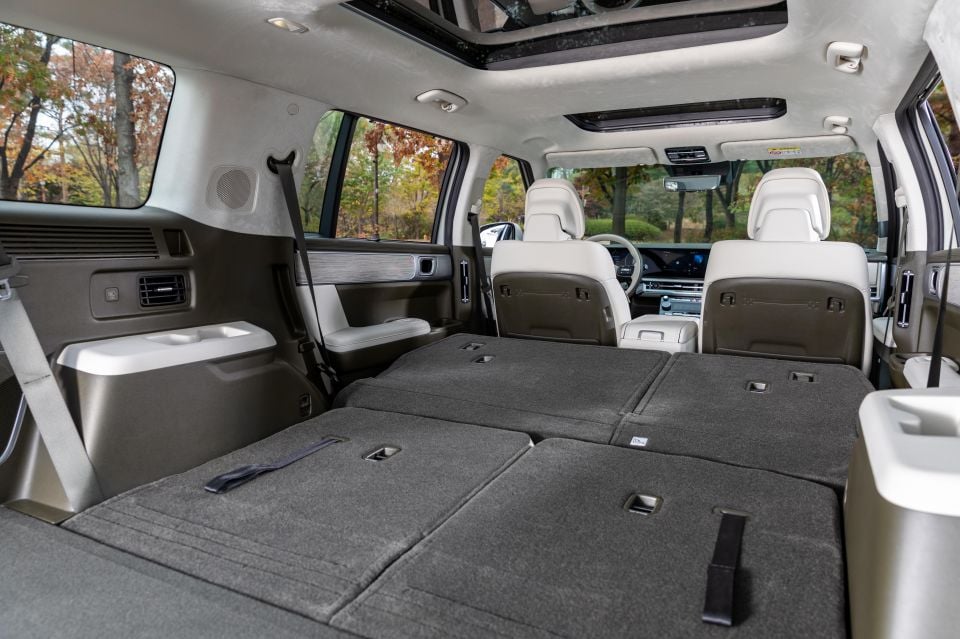
Amenities include a 220V outlet, air vents, fan speed control, cupholders plus the aforementioned two USB-C outlets.
The boxier shape aids cargo space too – claimed boot space is 725 litres with the third row folded, up 91L on the car it replaces.
Hyundai has confirmed four powertrains for the 2024 Santa Fe range, though we expect only two of them will come to Australia.
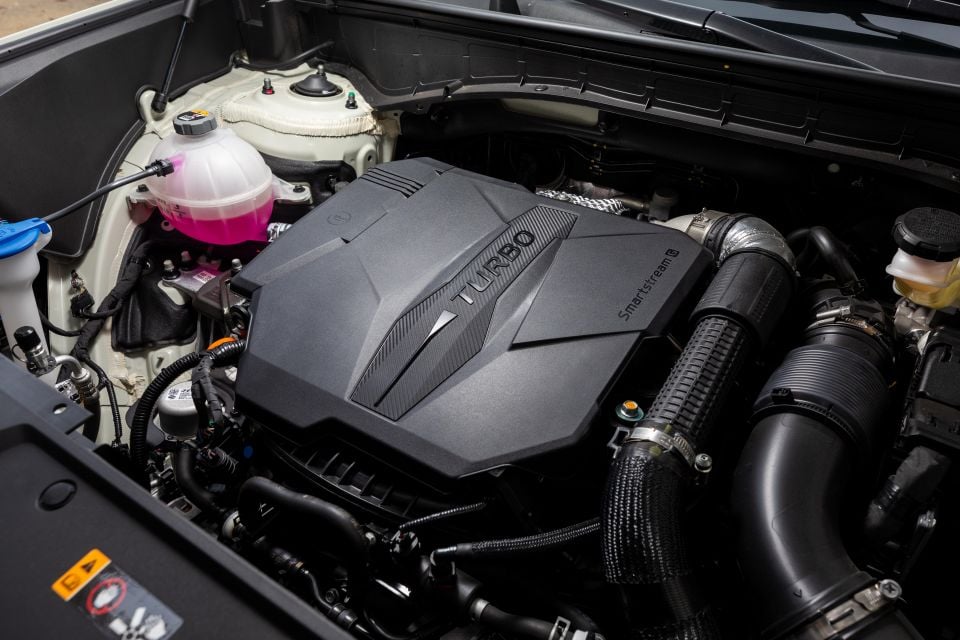
The entry-level naturally aspirated Theta III 2.5-litre four-cylinder petrol engine produces 143kW of power and 246Nm of torque, mated with an eight-speed automatic transmission for a claimed 0-100km/h time of 11.5 seconds. It’s highly unlikely to be coming to Australia.
The turbocharged version of this engine swaps the torque converter auto for an eight-speed dual-clutch unit, and bumps outputs up to 207kW and 422Nm, while slashing the 0-100km/h time to 8.0 seconds.
There are two electrified powertrains with Gamma III branding: a hybrid that has been confirmed for Australia, and a plug-in hybrid that is unlikely to come here.
The Santa Fe Hybrid features a turbocharged 1.6-litre four-cylinder petrol engine with 132kW and 265Nm mated with a 47.7kW electric motor, for a total system output of 173kW. It’s mated with a six-speed automatic transmission, and boasts a 0-100km/h time of 9.5 seconds.
Hyundai hasn’t published fuel economy figures for the Santa Fe as yet.
Most of our time was spent in a Santa Fe with the turbocharged 2.5-litre engine and front-wheel drive, with only a brief drive in a front-wheel drive hybrid.
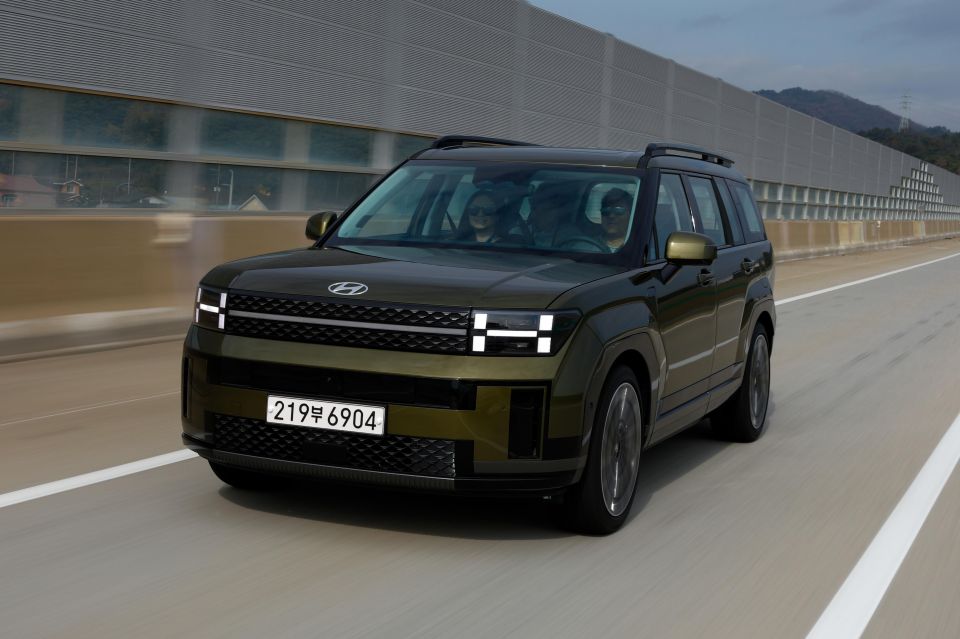
Where expert car reviews meet expert car buying – CarExpert gives you trusted advice, personalised service and real savings on your next new car.
On the road, the Santa Fe proves refined. There’s a slight rasp to the 2.5-litre turbo engine, but it’s subdued.
We did observe a fairly persistent wind buffeting noise, as though one of the windows had been wound down a crack. While not loud, it was noticeable in the context of this quiet cabin.
Given the hybrid powertrain is carried over, it comes as no surprise it feels much like the outgoing Santa Fe Hybrid.
Transitions between petrol and electric power are smooth, and if you feather the throttle you can stay on the latter at speeds of up to 50km/h in the city, though sometimes you’ll find the petrol engine fires up at as low as 15km/h.

The 2.5-litre turbo will be a much more dramatic departure for Santa Fe owners.
While this engine already features in the outgoing model in other markets since its mid-life update, Australia has been stuck with a naturally aspirated V6 that’s pleasant enough but not exactly thrifty, and available only with front-wheel drive.
With more torque available lower in the rev range, the 2.5T feels much more responsive than the old V6 and you don’t need to rev it as much to get the most out of it. There’s still some wheelspin, however, in the front-wheel drive model.
The eight-speed torque-converter automatic transmission has been substituted for an eight-speed dual-clutch transmission (DCT). We didn’t get to drive the Santa Fe through much in the way of inner-city gridlocked traffic, where DCTs can sometimes prove bothersome with low-speed vibration and clunky engagement.
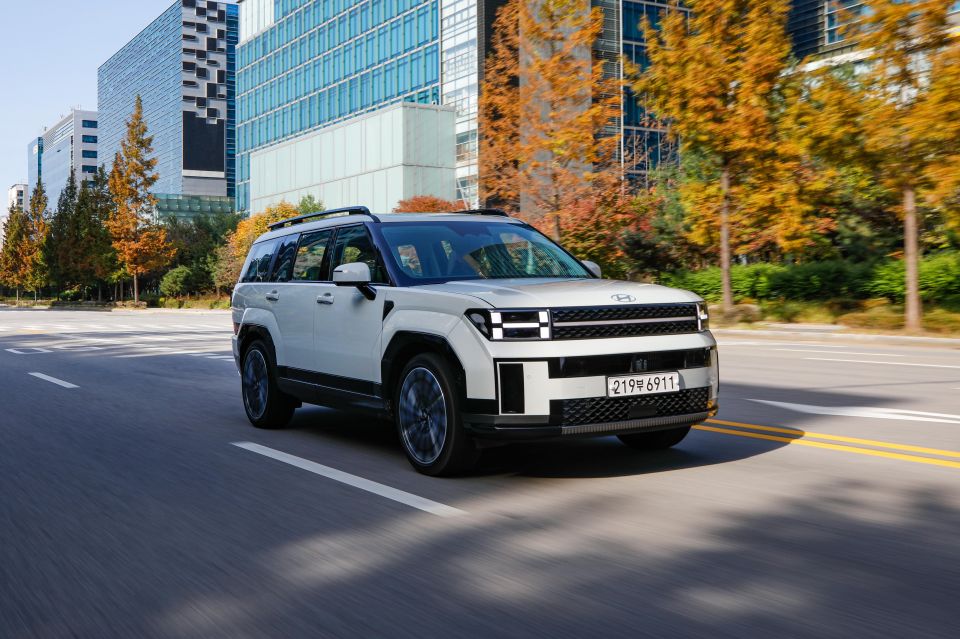
Our overall impression of the DCT proved positive, however. Shifts are smooth but rapid, and you’ll never feel the need to flick it into Sport or use the paddles.
I did find myself engaging Sport mode to try and dial in some more steering weight, but was left wanting. Fortunately, while the Santa Fe’s steering is a tad light for my liking, it’s far from being annoyingly vacant.
An upside of the relatively light steering is this large crossover is easy to park, with little arm-twirling required. You also won’t be frustrated taking the Santa Fe down some winding roads.
That’s exactly what we did with our 2.5T FWD tester on the island of Jindo in the very south of South Korea.
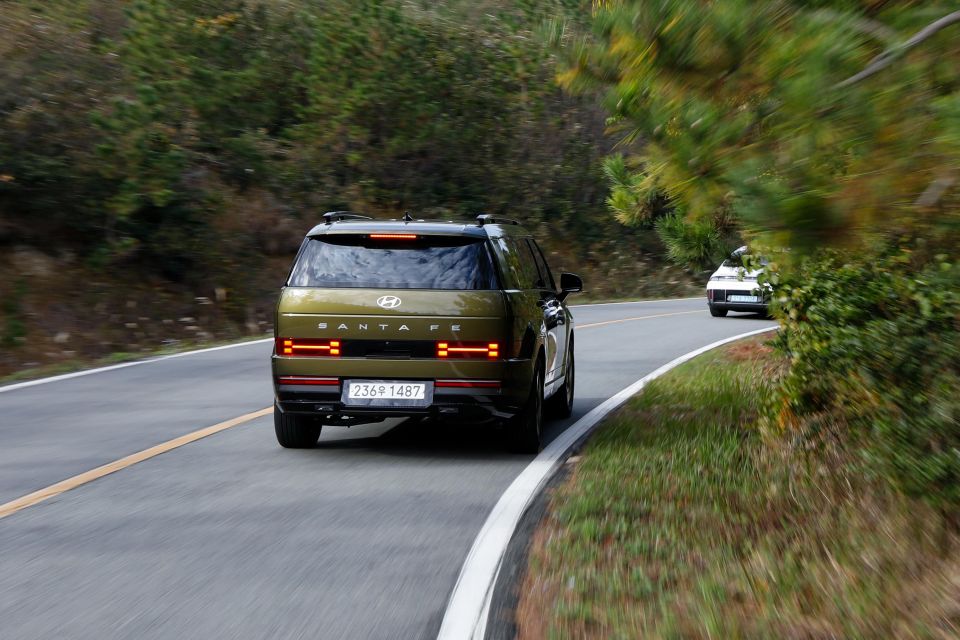
South Korean roads seem to be of a generally better standard than those in Australia, so we didn’t encounter much in the way of broken pavement. Nevertheless, the Santa Fe impressed with its comfortable ride quality.
There’s perhaps a touch of float to the way it rides and a little bit of patter over rougher surfaces, but the Santa Fe doesn’t feel like a barge.
Body control is good, with the Santa Fe feeling quite tied down. Even in tighter corners at higher speeds, body roll is well controlled.
Hyundai hasn’t confirmed whether Australia will get the same suspension tune as the Korean-market models we drove, but it’s highly unlikely the new Santa Fe will get a bespoke Australian-market suspension tune. It’s possible we could instead get a tune used in another market such as Europe.
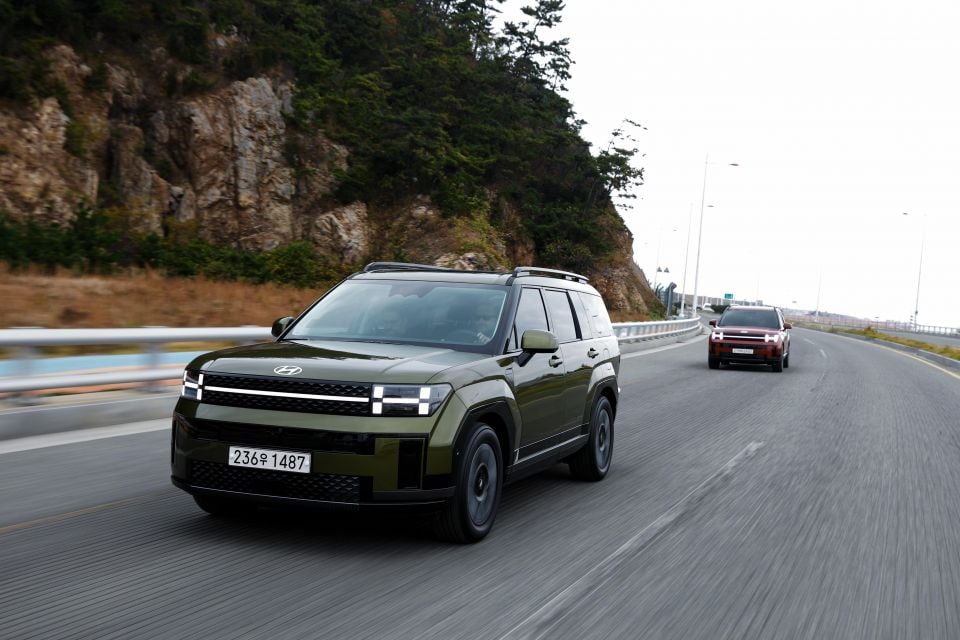
While shifts are rapid even in the normal drive mode, Sport did make our Jindo jaunt even more enjoyable, and didn’t hold onto gears annoyingly long as in some cars. There’s also a Custom drive mode that allows you to adjust individual settings.
We saw fuel economy of 6.7L/100km in the FWD hybrid and 9.6L/100km in the 2.5T FWD, however this wasn’t over identical drive routes. We’ll get more representative figures when the Santa Fe arrives in Australia.
Hyundai Australia hasn’t confirmed local specifications for the new Santa Fe, but we have an idea of what may become available based on the Korean market.
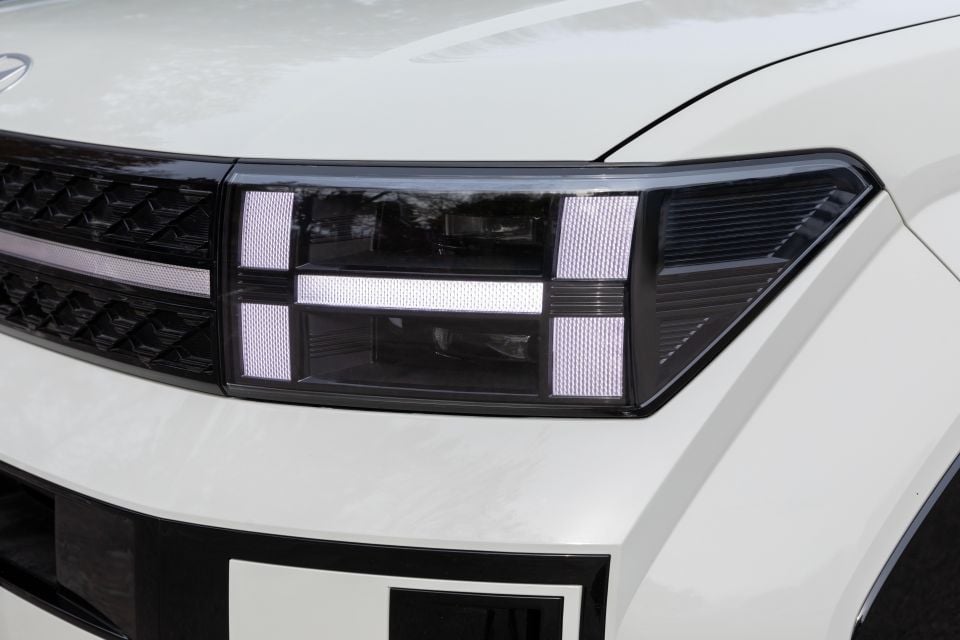
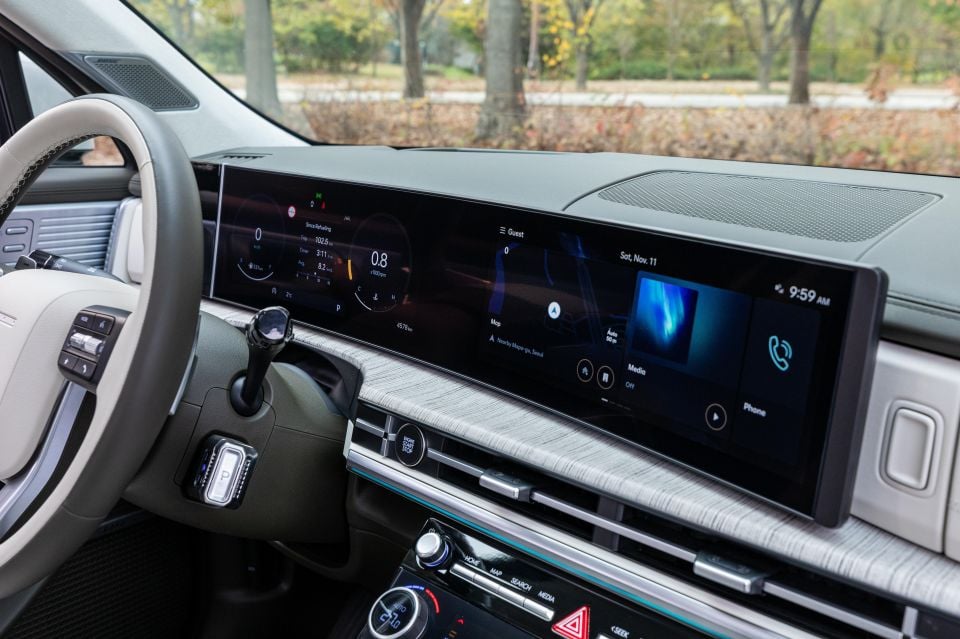
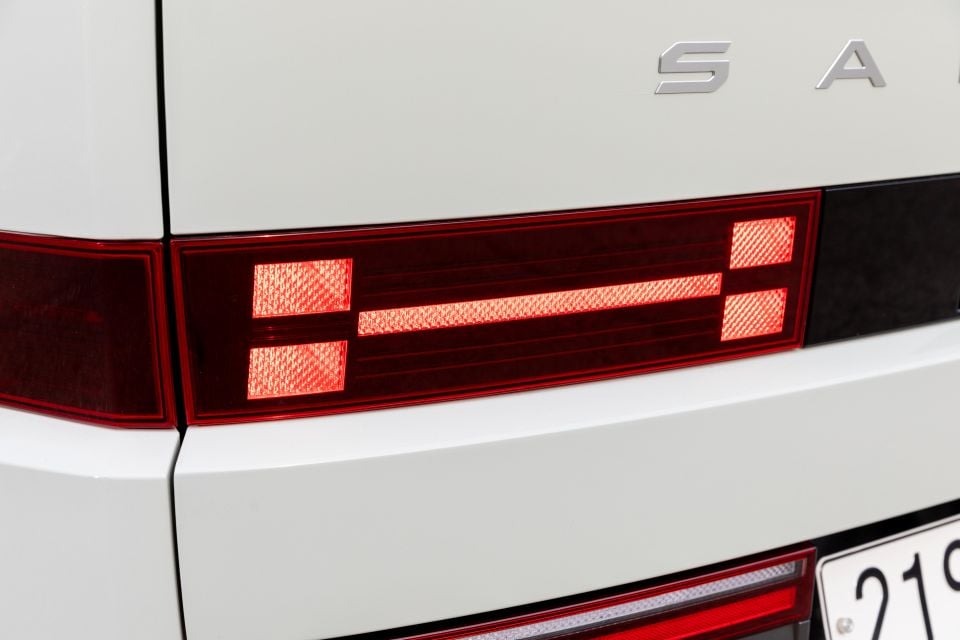

Available features include:
Digital Key 2 allows you to unlock the vehicle with an iPhone, Apple Watch or Android device, while there will also be – in Korea at least – a fingerprint authentication system and a built-in dashcam.
The new Hyundai Santa Fe has yet to be tested by ANCAP or Euro NCAP.

There’s a full suite of safety equipment available, including:
There’s also Highway Driving Assist 2 (HDA 2), which can keep the vehicle centred in its lane at a set speed and, when you hit the indicator stalk, complete a lane change manoeuvre for you.
A radar-based rear occupant alert feature can warn you if you’ve left a child or pet in the back after you’ve turned off the ignition.
Hyundai Australia backs its cars with a five-year, unlimited-kilometre warranty, and offers a capped-price servicing program.

Service pricing for the new-generation Santa Fe hasn’t been detailed as yet – we expect these details will become available closer to its launch in the new year.
The outgoing Santa Fe has been ageing quite well, particularly after a substantial mid-life update, and still looks and feels modern.

And yet, this new model makes it look like yesterday’s news. The conservative styling is gone, replaced with this brash, boxy exterior that not only makes the Santa Fe stand out in a car park, it also makes it more practical.
Third row space, in particular, is commendable, and superior to rivals like the Toyota Kluger. The hybrid remains a solid option, while the new 2.5T shapes up as a worthy replacement to the current V6. All models drive well, with balanced handling and a smooth ride.
The absence of a diesel is disappointing, but the new petrol engine is superior to the V6 it replaces and the thrifty hybrid is still thoroughly pleasant. Together, they help fill the void – though if Hyundai surprises us with a diesel reveal then that will be the cherry on top.
It remains to be seen how Hyundai will price the Santa Fe in Australia; but if the price doesn’t climb too much, Hyundai has a winner on its hands… provided Aussies embrace the styling.
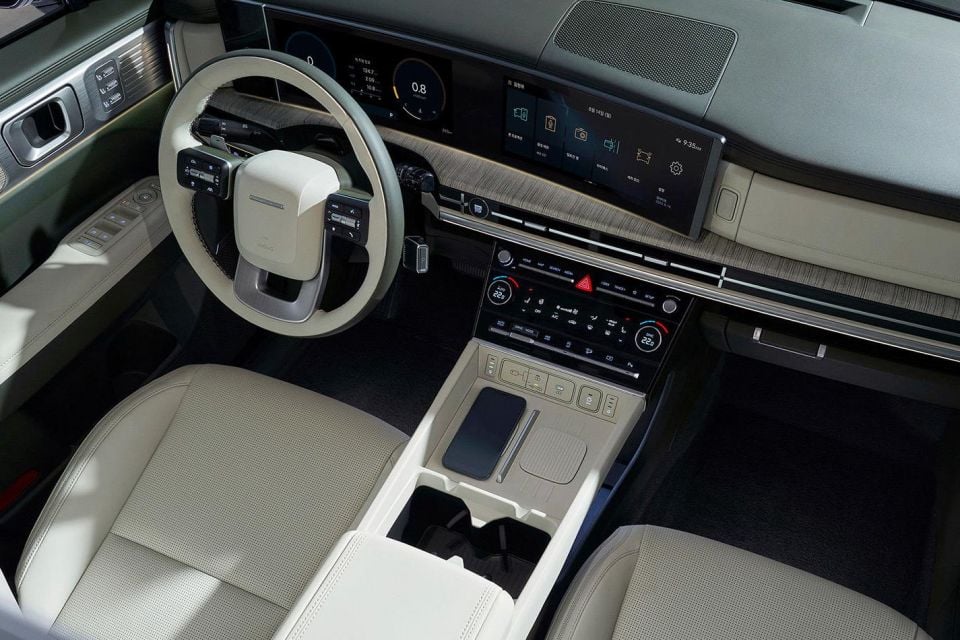
Click the images for the full gallery
BUY: Hyundai Santa Fe MORE: Everything Hyundai Santa Fe
Where expert car reviews meet expert car buying – CarExpert gives you trusted advice, personalised service and real savings on your next new car.
William Stopford is an automotive journalist with a passion for mainstream cars, automotive history and overseas auto markets.


William Stopford
19 Hours Ago


Matt Campbell
1 Day Ago


William Stopford
2 Days Ago


CarExpert.com.au
5 Days Ago


Max Davies
6 Days Ago


Damion Smy
7 Days Ago